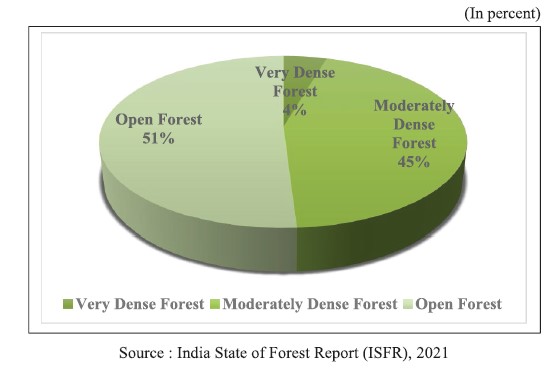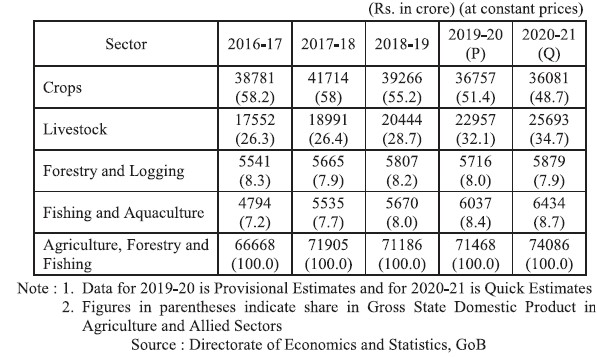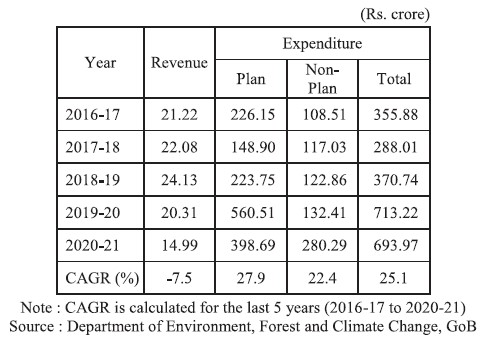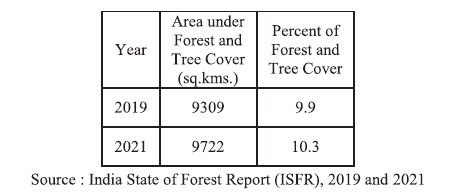Environment, Climate Change and Disaster management
Abstract:
- Economic growth and natural resource management must go in tandem with each Other for sustainable growth. The development policies in Bihar are fully mindful of this principle.
- In 2020-21, the contribution of forestry and logging stood 7.9 percent of the agricultural GSDP.
- Bihar received 1385 mms. of annual rainfall in 2020-21.
- Under the Jal-Jeevan- Hariyali Mission, nearly 3.92 crore saplings were planned in 2020-21 and about 4436 hectares of forest area was treated under soil and moisture conservation work.
- A ban on the use of disposable plastic and related substitutes has been imposed across the state.
- The Nature Safari of Rajgir, inaugurated by the Hon’ble Chief minister of Bihar on March 26, 2021, consists of several sites for nature-based recreational tourism.
- A total Rs. 176.18 crore has been sanctioned for construction and development of zoo Safari under the purview Of the Department ofEnvironment, Forest, and Climate Change.
- As regards Disaster Management, flood-induced damage has affected a total of 19 districts in the state, with a loss in crop production worth Rs. 727.88 crore.
- A mobile App, called as ‘Indravajra’ has been developed as part Of the Early Warning System for lightning.
- To the community, it provides warning at least 40 minutes before its occurrence within an area of 20 kilometres.
- During the second wave of the Covid-19 pandemic (May-June 2021), a total Of 739 community kitchens were operational across the state and a total of 57.36 lakh meals were provided by the Department of Disaster Management.
Introduction:
- The concept of resource conservation and environmental sustainability have gained prominence in the recent decades, particularly after the United Nations announced Sustainable Development Goals (SDG), 2030.
- In economies such as Bihar, achieving high and sustainable economic growth is a pre-cursor for ending hunger, poverty, and inequality.
- Therefore, growth policies and natural resource management must go hand in hand for the growth to be sustainable.
- On account of rapid population growth and high population density (as high as 1106 people per km., according to Census 2011), Bihar faces serious resource constraints.
- The current Covid-19 crisis has further brought into focus the linkages of growth with environmental concerns, such as climate change and pollution.
- Therefore, integrating overall environmental considerations into economic growth has become a high priority for the State Government.
- The Department of Environment, Forest, and Climate Change serves as the nodal agency and it fully shares the national vision of conservation and sustainable management of forest, biodiversity, and other environmental resources in the state.
Climate Change:
- Bihar is highly vulnerable to natural calamities, such as drought, earthquake, and high-speed
- wind/cyclone.
- Bihar’s climate is primarily sub-tropical with peak summer months from March to
- May, and winter temperatures during December to January.
- Since most of the population is dependent on primary sectors, such as crop, livestock, forestry and logging, fishing, and aquaculture, favourable climatic conditions are critical for the state’s economy.
Rainfall:
- The changes in rainfall, in terms of adequacy and timeliness, reflect one of the direct repercussions of global warming. In recent decades, the rainfall and weather patterns have become more unpredictable, which obviously has a negative impact on agriculture and related sectors that support livelihood of most of the rural households in the state.
- The state received a total of 1385 mms. of rainfall during 2020, which was about 37 percent higher than the long-run average rainfall of 1012 mms (Average rainfall between 2001-2020 = 1012 mms.).
- Bulk of this rainfall occurred during the south-west monsoon (June to September), accounting for 83.7 percent of the total rainfall.
- The rest of the rainfall occurred on account of winter rain, hot-weather rain, and the north-west monsoon, which together contributed to the remaining 3 percent rainfall in 2020-21.
- In 2020, Kishanganj received the highest rainfall of 2765 mms., followed by Supaul (1953 mms and West Champaran (1920 mms.). The lowest rainfall was recorded in Arwal (769 mms.).
- Out of the 38 districts, 18 districts received rainfall higher than the state’s average of 1385 mms. in 2020.
Temperature:
- Across the world, one of the most obvious effects of global warming is the increase in atmospheric temperature, which is affecting weather and climate patterns. Bihar is also experiencing such effects.
- Uneven weather patterns increase risks and uncertainties, which have implications for agricultural production, crop yields, and availability of water for different purposes. Beyond effects on cropping pattern and crop productivity, changes in temperature also influence aquatic ecosystems and bio-diversity pattern.
- The trends in annual average, minimum, and maximum temperature for Bihar during 2011-12 to 2020-21:
- The average temperature during 2011-12 to 2020-21 was 23.5 degree Celsius. In the last decade, the maximum temperature ranged between 38.4 degree Celsius in 2020-21 and 46.4 degree Celsius in 2012-13.
- The lowest minimum temperature of the decade was observed during 2013-14 at 1.1 degree Celsius in Bihar.
- In recent years, the heat waves have been more common during the summer months of March-June, while the winter months of December-February are getting slightly warmer.
Forest Resources
- As an important renewable resource, forests are crucial for preserving ecological balance, regulating climate and hydrological cycles, providing habitat for different species and biodiversity, supplying raw materials for industrial use, and many Other factors.
- Forests also perform a variety of functions, such as soil conservation, providing timber for wood products, and recreational opportunities for human beings.
- Bihar is rich in deciduous natural sal forests, which are found mainly in the southern districts such as Rohtas, Aurangabad, Kaimur, Nawada, Jamui, Munger, Banka and Gaya.
- The district of West Champaran in the northem plains has moist forests.
- Overall, forestry and logging contributed about 1.5 percent of the Gross State Domestic
- (GSDP) in Bihar during the last five years (2016-17 to 2020-21).
- The share of forestry and logging sector in agricultural Gross State Domestic Product (GSDP) during 2016-17 to 2020-21:
- Its share in Agricultural GSDP averaged around 8.1 percent in the last five years.
Revenue and Expenditure of the Department
- The trends in revenue and expenditure of the Department of Environment, Forest, and Climate Change for 2016-17 to 2020-21:
- In case of aggregate revenue, an increasing trend can be observed during the period 2016-17 to 2019-20.
- As of 2019-20, the revenue of the Department stood at Rs. 20.31 crore, after which, there has been a decline to Rs. 14.99 crore in 2020-21.
- In terms of total expenditure, there has been a steady increase from Rs. 355.88 crore in 2016-17 to Rs. 693.97 crore in 2020-21, registering a growth rate of 25.1 percent.
- Within expenditure, the growth in plan expenditure increased to Rs. 398.69 crore in 2020-21, from Rs. 226.15 crore in 2016-17, indicating an annual growth rate of 27.9 percent.
- This clearly shows that the Department of Environment, Forest, and Climate Change has been provided with substantial financial resources to meet its wide range of objectives.
Forest Cover
- All tree patches with a crown density of more than 10 percent, covering an area of 1 hectare or more, are considered as forest cover, regardless of their legal status.
- Area under Forest and Tree Cover in Bihar(2019 and 2021):
- Bihar’s total forest and tree cover was approximately 9722 sq. kms. in 2021 , which includes natural forests in 12 districts and tree-dominated vegetation that also qualifies as forests.
- The forest and tree cover together account for 10.3 percent of the total geographical area of the state as per the India State of Forest Report (ISFR), 2021.
- Recognizing the importance of forest resources in mitigating the effects of climate change, the State Government is committed to increasing forest cover further and ensuring sustainable use of forest products.
- Through the Jal-Jeevan-Hariyali Mission, efforts are being made to improve not only the forest cover through afforestation, but also the quality of forest resources to ensure environmental sustainability.
- In 2021, the highest forest cover in the state was reported from Kaimur (1051.6 sq. ), followed by West Champaran (903.3 sq. kms.) and Rohtas (669.9 sq. kms.), which together accounted for nearly 35.6 percent of the total forest cover in the state.
- In terms of types of forests, West Champaran recorded the largest area (249.3 sq. kills.) under Very Dense Forest (crown density cover above 70 percent), while with regard to Open Forest (crown density cover ranging between 10 and 40 percent), Kaimur was the leading district (531.7 sq. kms).
- In terms of the forest canopy density, denser forests are more likely to be found to be more in the southern parts of the State.
- The forests are classified into Very Dense Forest (VDF) (crown density of more than 70 percent), Moderately Dense Forest (MDF) (crown density between 40 and 70 percent), and Open Forest (OF ) (crown density Of 10 to 40 percent), based on their canopy density.
- The area under Open Forest (OF ) is the highest in Bihar (3762 sq. kms.) in 2021, followed by area under Moderately Dense Forest (MDF) at 3286 sq. kms.
- In 2021, the Open Forest constitute about 51 of the total forest area, followed by Moderately Dense Forest at 44.5 percent and Very Dense Forests at 4.5 percent.

- As per the Agroforestry Policy of 2018 of the State Government, various efforts are going on to bring more area under green cover in the coming years.
Carbon Stock
- Deforestation and use of fossil fuels, which contribute to global warming, have become a major environmental concern across the globe. Ensuring adequate green cover is one of the ways to mitigate such effects, as they help in moderating surface temperature and balancing the climate.
- Forest ecosystems are integral to regulating carbon stocks, as they take carbon dioxide from the atmosphere and convert it to biomass.
- The five major pools of carbon in forests include:
- Above ground biomass (tree trunk, branches, leaves, shrubs),
- Below ground biomass (root system),
- dead wood,
- litter, and
- soil organic carbon (SOC).
- The above ground biomass and below ground biomass are mostly the two reservoirs of living carbon in biomass.
- Bihar had a carbon stock of 55.24 million tonnes in 2019, which accounted for about 0.8 percent of the total forest carbon of the country.
- Among the different pools, the highest carbon stock was from the Soil Organic Carbon, reporting about 46.4 tonnes of carbon stock per hectare, followed by above ground biomass, With 20.54 tonnes of carbon stock per hectare stock in 2019.
- The forest carbon stock in Soil Organic Carbon was 33.93 million tonnes in 2019, which is higher than 28.86 million tonnes in 2017.
- In 2019, Soil organic carbon (SOC) contributed the most to carbon accounting for 61.4 percent. The Share of other components in total carbon forest pool were — Above Ground Biomass (27.2 percent), Below Ground Biomass (9.8 percent), Litter (1.4 percent) and Dead wood (0.2 percent).
- The State Government is making various efforts to increase carbon through cultivation of more trees in farms.
Forest Fire:
- Climate change causes more frequent and severe forest fires, resulting in degradation of forest resources, loss of forest produce, and increase in soil erosion and spread, all of which harm the forest ecosystem.
- Bihar’s forests are particularly prone to fires, which cause severe disruption to standing Rabi crops. The task of conservation of forests and biodiversity becomes more difficult in case of frequent forest fires.
- Overall, nearly 13,746 sq. kms. of area is prone to forest fires in the state
- Out of which only 15 percent (399.64 sq. kms.) are very highly prone to forest fires.
- About 52.4 of the total forest area (10,729 sq. kms.) belong to the less fire-prone area.
- In 2020-21, among the divisions, the highest number of incidents was reported in Munger (162 incidents), followed by VTR-2 (121 incidents), and VTR-1 (95 incidents).
- In 2020-21, the total burnt area in the state stood at 572.4 hectares.
- A large number of forest fire incidents in the state, leading to loss of trees, crops, property, and human lives, have necessitated adoption of suitable institutional mechanisms and undertaking rehabilitation efforts to provide relief measures in the state.
- The advisories are being issued to the village community through the Bihar State Disaster Management Department (BSDMD), against burning of crop stubble and cooking after 9 a.m. during the summer season to prevent forest fires. ©crackingcivilservices.com
Diversion of Forest Area:
- Forest resources are being gradually depleted, because Of increasing demand for forest resources on account of industrialization, population growth, and various developmental activities.
- As per the estimates of the concerned Department, during 2016-17 to 2020-21, a total of 208 projects were undertaken in Bihar, which necessitated conversion of 1603.78 hectares of forest land for different developmental works.
- These works included laying of pipelines, road construction, irrigation works, and development of rail network.
-
Initiatives of the Department
- Hariyali Mission:
- Under the Hariyali mission, planting activities are being undertaken to increase the green cover of the state.
- Under Krishi Vaniki Scheme, 21.53 lakh saplings have been planted. Apart from that, about 25.6 lakh saplings of fruit-bearing species and timber species have been distributed among the people in the fringe villages of the forest.
- With the help Of SHGs under JEEViKA, 365 units of nurseries have been set up among the farmers. In these 365 nurseries and other Kisan Nurseries, 73 lakh plants will be raised under the Mukhyamantri Niji Paudhshala scheme and 22 nurseries will be set up.
- National Afforestation Programme: Under the National Afforestation Programme, about 6.95 lakh saplings were planted in 1000 hectares of area in the forests of Banka, Munger, and Rohtas districts in 2019-20.
- In 2020-21, about 1306 lakh saplings have been planted in 1935 hectares area of the forest.
- Namami Gange: Under the Namami Gange scheme, large-scale plantation drive has been undertaken in forest divisions along river Ganga and its subsidiary rivers.
- In 2021-22, about 50 lakh saplings have been planted.
- Bamboo Mission: Under the Krishi Vaniki Scheme, bamboo saplings are being planted on government land and in nurseries of the farmers. Bamboo plants are being distributed to them as per their demand.
- CAMPA Section: Compensating the loss of ecological services due to forest diversion for non- forestry purposes is the main objective of Compensatory Afforestation Fund (CAMPA).
- This fund gives priority to the regeneration and development of forests.
- In 2020-21, about 28.16 hectares of forest was treated for soil and moisture conservation through CAMPA, as per plan Rs. 239.46 crore.
- In 2021-22, about 79.59 lakh saplings have been planted against the target of 88.10 lakh saplings.
- Wetland: The Bihar State Wetland Board has been established in 2020.
- A total of 28 wetlands, with an area of more than 100 hectares, have been identified for Integrated Management.
- Kanwar-Tal Wetland in the district of Begusarai has been included as the 38th ‘Ramsar Site’ and has been considered as an important international wetland.
- Jal-Jeevan-HariyaIi Mission: Under the Mission, the target for planting of trees was fixed at 2.51 crores for 2020-21. The achievement against the target was 92 crores of trees, crossing the target.
- Further, about 4436 hectares of forest area was treated under soil and moisture conservation work.
- To achieve this, about 275 Departmental nurseries and 365 Kisan Nurseries were established to procure 439.64 lakh saplings.
- Under this mission, a target for planting 5 crore plants has been fixed for 2021-22. As of November 2021, nearly 3.88 crore saplings have already been planted.
- Under the Jal-Jeevan Hariyali Mission, extensive afforestation is being carried out across the state by the Department of Environment, Forest, and Climate Change, in collaboration with other departments.
- One such collaboration is with the Rural Development Department, where the component of Natural Resource Management (NRM) is an integral part of the Mahatma Gandhi National Rural Employment Guarantee Scheme (MGNREGS).
- In order to accomplish its mission objectives, the following six components of the mission were provisioned in convergence with MGNREGS.
- To renovate public water storage bodies, like public pond and Ahars/Pynes : The number of renovated ponds through MGNREGS in 2020-21 is 6097.
- To construct soak pits, recharge structures and other water harvesting structures and public tubewells:
- This is being done to prevent the loss of used water extracted from wells and tubewells. The construction of such structures is necessary to maintain the groundwater level.
- A total of 85,233 soak pits have been in 2020-21.
- To create new water sources (constructing farm pond on individual agriculture land):
- The aim of construction of farm pond is to take Surplus River water to water-deficient areas. Under MGNREGS, in 2020-21, 4952 farm ponds were constructed on lands of identified individual beneficiaries.
- To construct check dam and other water harvesting structures in catchment areas of small rivers and large drains and hilly areas: To prevent water loss and to use this water in irrigation, 1701 cheek dams were constructed in 2020-21.
- To construct rooftop rain water harvesting structures on government buildings:
- Though the state gets plenty of rainfall, due to lack of proper conservation structures, large quantities of water go waste.
- To prevent this loss, construction of 1326 rainwater harvesting structures is being undertaken on rooftops of government buildings.
- Plantation around water storage structures, and roads of Rural Works Department: To increase vegetative and green cover and control pollution, extensive afforestation is being carried out across the state.
- Plantation is being carried out on the lands of identified beneficiaries of MGNREGS, around waterbodies and on the sides of the roads, through MGNREGS.
- In 2020-21, 120.46 lakh saplings were planted, resulting in an increase in the vegetative cover in the state.
- It brought benefits to more than 50 thousand poor and marginalized rural families.
- In 2021-22, the target for plantation under MGNREGS is 200 lakh plants.
- Ban on Immersion of Puja Idols in Any Streams: There shall be a complete ban on immersion of idols in any stream.
- The puja Committees shall ensure that the idols are made of natural materials such as clay, bamboo etc., and such materials like Plaster of Paris or other toxic non- biodegradable chemicals are not used in idol making.
- Also, idols can be immersed only in designated immersion spots or artificial ponds, earmarked for the puja committee.
- In 2020-21, the achievements by the Department of Environment, Forest, and Climate Change:
- Financial achievement: 96.08 Crore in 2020-21
- Physical achievement: 397.46 lakh plants. ©crackingcivilservices.com
- Hariyali Mission:





